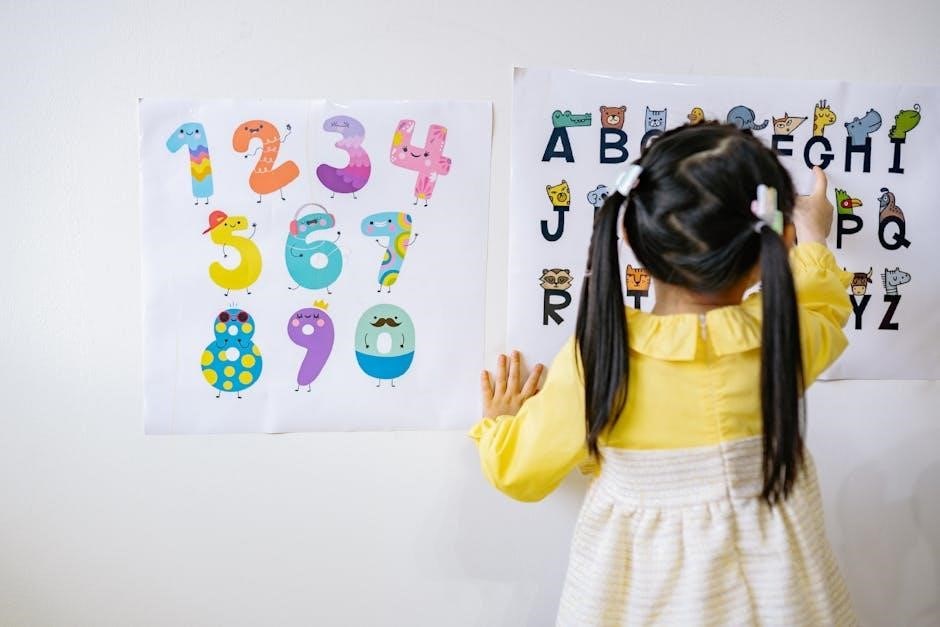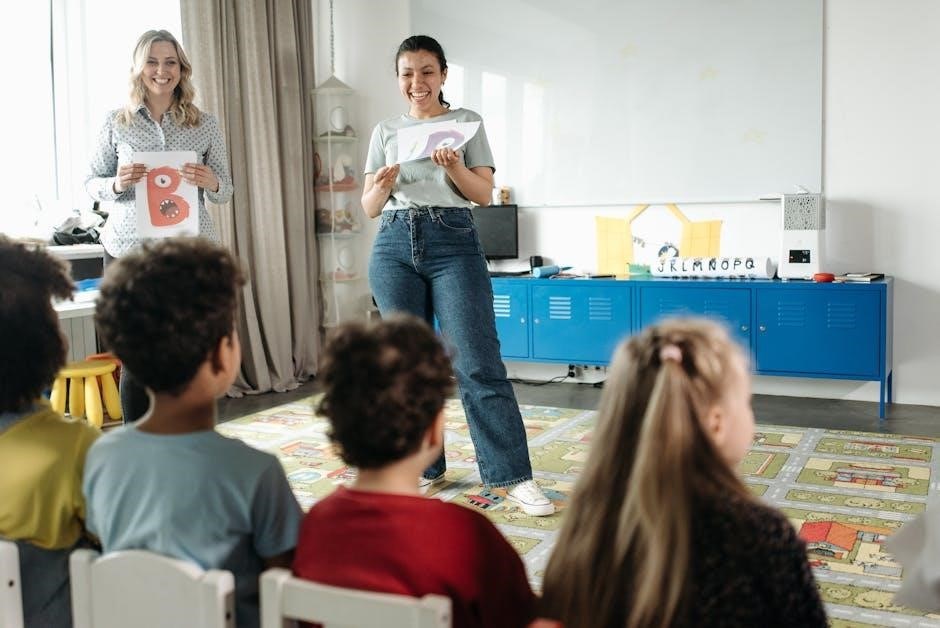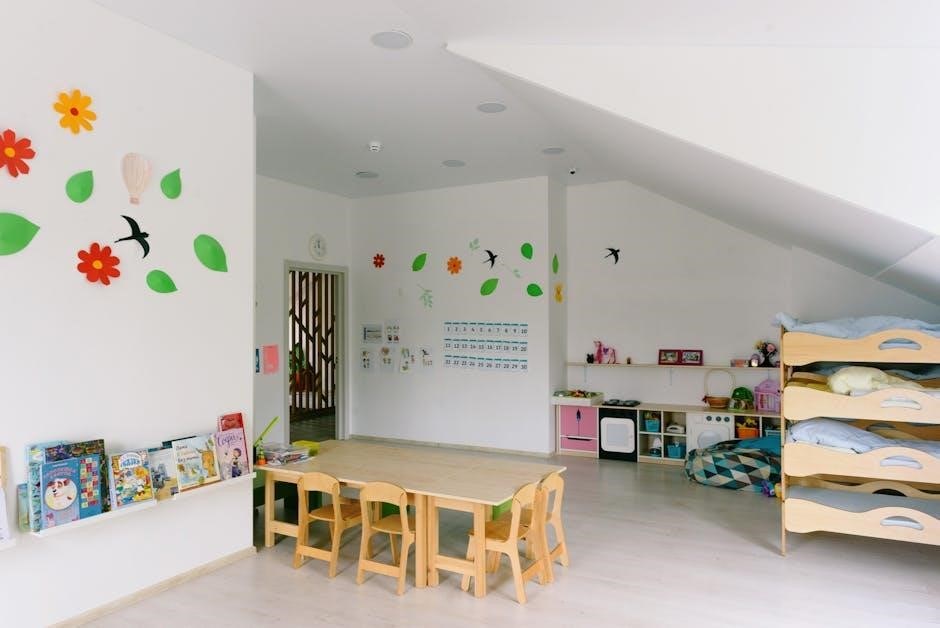HMH Into Reading Kindergarten is a comprehensive literacy program designed for young learners, focusing on foundational reading and writing skills through engaging, research-based activities.
1.1. Overview of the HMH Into Reading Program
HMH Into Reading is a research-based literacy program designed to foster a love of reading and writing in kindergarten students. It integrates foundational skills, reading, writing, and speaking, ensuring a holistic approach to early literacy. The program emphasizes interactive activities, real-world texts, and engaging content to captivate young learners. By aligning with educational standards, HMH Into Reading supports teachers in delivering structured, effective lessons. Its comprehensive design ensures that students build a strong foundation for future academic success. The program also encourages family involvement, creating a seamless connection between classroom learning and home practice.
1.2. Importance of Early Literacy in Kindergarten
Early literacy in kindergarten is crucial as it builds the foundation for future academic success. It enhances phonological awareness and vocabulary, which are essential skills. Kindergarten is when children start to connect sounds with letters and understand basic story structures. Mastering these skills early helps children read with more fluency and comprehension as they progress. Additionally, early literacy fosters a love for reading, which can lead to better overall academic performance and a lifelong enjoyment of learning. HMH Into Reading supports this by providing engaging activities that make learning fun and interactive, ensuring children develop these critical skills in a supportive environment, preparing them for the challenges of grade school and beyond.
1.3. Structure of the HMH Into Reading Curriculum
The HMH Into Reading curriculum is thoughtfully structured to support kindergarten students in developing essential literacy skills. It begins with foundational concepts such as phonological awareness and progresses to more complex skills like decoding and comprehension. The program is divided into sequential lessons, each building on the previous one, ensuring a smooth transition for young learners. It integrates reading, writing, and speaking to create a holistic approach to literacy. The curriculum includes hands-on activities, engaging stories, and systematic instruction to keep students motivated and focused. By combining direct teaching with interactive exercises, HMH Into Reading creates a dynamic learning environment that fosters confidence, curiosity, and a strong foundation for future academic success.

Key Components of HMH Into Reading Kindergarten
HMH Into Reading Kindergarten emphasizes foundational reading skills, phonics, and integrated reading-writing connections, ensuring a comprehensive approach to early literacy development for young learners.
2.1. Foundational Reading Skills Development
HMH Into Reading Kindergarten focuses on building strong foundational reading skills through systematic instruction and interactive activities. The program emphasizes phonemic awareness, decoding, and comprehension strategies to ensure young learners develop a solid base for reading proficiency. By incorporating engaging texts and hands-on exercises, the curriculum helps students recognize patterns, understand word structures, and apply reading skills confidently. Fluency and vocabulary development are also prioritized, enabling kindergartners to progress seamlessly toward independent reading. These foundational skills are essential for fostering a lifelong love of reading and preparing students for future academic success.
2.2. Integrated Reading, Writing, and Speaking
HMH Into Reading Kindergarten seamlessly integrates reading, writing, and speaking to create a holistic literacy experience. Students engage in reading texts that inspire creative writing and thoughtful discussions, fostering connections across skills. Writing activities are closely tied to reading lessons, encouraging students to express ideas clearly. Speaking exercises, such as class discussions and presentations, enhance communication skills and comprehension. This integrated approach helps kindergartners build a deeper understanding of language and storytelling, while developing confidence in their ability to express themselves. By linking these essential skills, the program prepares young learners for a smooth transition to more complex literacy tasks in higher grades.
2.3. Role of Phonics in the Curriculum
Phonics plays a central role in HMH Into Reading Kindergarten, serving as the foundation for decoding and reading proficiency. The curriculum employs systematic and explicit instruction to teach phonemic awareness, alphabet knowledge, and sound-letter relationships. Students learn to recognize and manipulate sounds in words, blend sounds to form words, and segment words into individual sounds. Engaging activities, such as hands-on manipulatives and interactive digital tools, help make phonics instruction lively and accessible. The program emphasizes the connection between phonics and reading comprehension, ensuring students understand how these skills work together to build fluent and confident readers. This structured approach ensures all learners master essential phonics skills.

Teaching Methodologies in HMH Into Reading
HMH Into Reading incorporates systematic instruction, differentiated learning, and technology integration to create engaging lessons. These methodologies ensure all students receive tailored support and stay motivated.
3.1. Systematic and Explicit Instruction
The HMH Into Reading program emphasizes systematic and explicit instruction, breaking down foundational reading skills into manageable parts. This approach ensures clarity and consistency, allowing students to build a strong literacy base. Teachers use direct teaching methods, modeling skills, and guiding practice to reinforce learning. The program’s structured sequence ensures students master each concept before progressing, fostering confidence and fluency. Explicit instruction supports diverse learners by providing clear explanations and scaffolded support, making complex skills accessible. This methodology aligns with research-based practices, ensuring all students receive the instruction they need to succeed. By focusing on systematic delivery, HMH Into Reading helps kindergartners develop essential reading skills effectively.
3.2. Differentiated Instruction for Diverse Learners
HMH Into Reading Kindergarten incorporates differentiated instruction to meet the diverse needs of learners. The program offers flexible grouping strategies, leveled readers, and hands-on activities to cater to varying skill levels. Teachers can adapt lessons to support students who need extra practice or challenge advanced learners. The curriculum also integrates technology, providing interactive tools that engage different learning styles. By recognizing that each child learns uniquely, the program ensures equitable access to literacy skills. This approach fosters an inclusive classroom environment, allowing every student to thrive and build confidence in their abilities. Differentiated instruction in HMH Into Reading helps educators address individual needs, promoting academic success for all kindergarten students.
3.3. Use of Technology for Engaging Lessons
HMH Into Reading Kindergarten seamlessly integrates technology to create engaging and interactive learning experiences. The program includes digital tools, such as online games, videos, and interactive whiteboard activities, to captivate young learners. These resources are designed to make reading and writing fun while reinforcing foundational skills. Teachers can access a variety of multimedia content to differentiate instruction and meet the needs of all students. Additionally, the curriculum offers mobile-friendly resources, allowing families to support learning at home. By leveraging technology, HMH Into Reading Kindergarten creates a dynamic and inclusive environment that fosters student engagement and motivation, preparing them for success in a tech-driven world.
Assessment and Progress Monitoring
HMH Into Reading Kindergarten includes systematic assessments to track students’ progress, ensuring teachers can identify strengths and areas for growth, guiding targeted instruction effectively.
4.1. Formative Assessments in the Classroom
Formative assessments in HMH Into Reading Kindergarten are integral for monitoring student progress and understanding. These ongoing evaluations, conducted throughout lessons, help teachers gauge mastery of skills like phonics, vocabulary, and comprehension. Through observation, short quizzes, and class discussions, educators identify areas where students may need additional support. The program incorporates interactive activities and progress checks to ensure learning stays on track. This approach allows for timely adjustments to instruction, keeping the curriculum responsive to student needs. By providing immediate feedback, formative assessments not only guide teaching but also empower students to reflect on their own learning, fostering a growth mindset and engagement in the classroom.
4.2. Summative Assessments to Track Progress
Summative assessments in HMH Into Reading Kindergarten provide a comprehensive evaluation of students’ learning at the end of instructional units or periods. These assessments measure mastery of key skills such as decoding, fluency, and comprehension. The program includes unit tests, performance tasks, and end-of-module projects to track progress. Results from summative assessments help teachers identify areas of strength and weakness, as well as determine if students are meeting benchmarks. This data is crucial for reporting progress to parents and informing future instruction. By assessing overall achievement, summative evaluations ensure students are well-prepared for subsequent lessons and long-term academic success.
4.3. Data-Driven Instructional Decisions
HMH Into Reading Kindergarten emphasizes the use of assessment data to inform and refine teaching practices. Teachers analyze results from formative and summative assessments to identify individual and class-wide learning patterns. This data helps tailor instruction to meet specific student needs, ensuring targeted support and enrichment. The program provides tools for tracking progress over time, enabling educators to adjust lesson plans dynamically. By leveraging data, teachers can address skill gaps, enhance engagement, and ensure all learners stay on track. This approach fosters a culture of continuous improvement, where instruction is responsive and aligned with student performance, ultimately supporting equitable and effective learning outcomes for all kindergarten students.

Parent and Home Involvement
HMH Into Reading Kindergarten encourages active parent participation through resources and strategies for home practice, fostering a reading-rich environment that supports learning and development.
5.1. Strategies for Parent-Teacher Collaboration
Effective parent-teacher collaboration is crucial for supporting young learners. HMH Into Reading Kindergarten provides resources to foster partnerships, including regular communication, parent-teacher workshops, and shared progress updates. Teachers can offer guidance on reinforcing literacy skills at home, while parents can share insights into their child’s learning preferences. Digital platforms and newsletters are often used to keep families informed about classroom activities and ways to extend learning. By working together, parents and educators create a cohesive learning environment that promotes consistency and accelerates student growth. This collaborative approach ensures that every child receives tailored support, bridging the gap between home and school for optimal literacy development.
5.2. Resources for Home Practice and Reinforcement
HMH Into Reading Kindergarten provides a range of resources to support home practice, ensuring students can reinforce their literacy skills outside the classroom. Activity sheets, interactive digital tools, and reading guides are available through an online portal, offering parents easy access to materials that align with classroom learning. These resources include phonics practice, sight word lists, and comprehension exercises tailored to the curriculum. Additionally, tips for creating a reading-rich environment are shared, such as dedicating daily reading time and engaging in discussions about stories. Parents can also monitor progress through digital reports and activities designed to complement classroom instruction, fostering a consistent learning experience at home.
5.3. Building a Reading-Rich Home Environment
Creating a reading-rich home environment is crucial for fostering a love of learning in kindergarten students. HMH Into Reading Kindergarten encourages parents to establish dedicated reading spaces with accessible books and materials. Displaying books attractively and rotating them regularly keeps children engaged. Families are advised to incorporate daily reading routines, such as reading aloud together or discussing favorite stories. Additionally, parents can enrich the environment by labeling objects, fostering a print-rich space, and encouraging discussions about written materials. These practices help students connect learning at school with experiences at home, reinforcing their literacy development and building a strong foundation for lifelong reading habits.

Benefits of HMH Into Reading for Students
HMH Into Reading Kindergarten fosters improved reading confidence and fluency while enhancing vocabulary and comprehension skills, preparing students for future academic success.

6.1. Improved Reading Confidence and Fluency
HMH Into Reading Kindergarten is designed to build students’ reading confidence and fluency through systematic instruction and engaging activities. The program emphasizes phonics, decoding, and comprehension skills, allowing young learners to progress at their own pace. Interactive lessons and repetitive practice help students feel more comfortable reading aloud, reducing anxiety and fostering a love for reading. As they master basic skills, their ability to read with accuracy and expression grows, leading to increased confidence. Fluency is reinforced through shared reading experiences and opportunities to apply skills in meaningful contexts, ensuring students develop the foundational abilities needed for long-term reading success.
6.2. Enhanced Vocabulary and Comprehension Skills
HMH Into Reading Kindergarten actively enhances vocabulary and comprehension skills through engaging, research-based instruction. The program introduces new words in context, encouraging students to connect meanings to stories and discussions. Interactive activities and shared reading experiences foster deeper understanding of texts. By integrating reading, writing, and speaking, the curriculum helps students build a robust vocabulary and develop critical thinking skills. This structured approach ensures young learners can interpret and analyze texts effectively, laying a strong foundation for future academic success. The program’s focus on comprehension strategies, such as visualizing and summarizing, equips students with tools to engage meaningfully with written material.
6.3. Preparation for Future Academic Success
HMH Into Reading Kindergarten plays a pivotal role in preparing students for future academic success by establishing a robust foundation in literacy. The program’s emphasis on phonics, comprehension, and vocabulary ensures that young learners develop the essential skills needed for higher-grade challenges. By fostering a love for reading and learning, HMH Into Reading equips students with the confidence and academic readiness to excel in subsequent years. The curriculum’s structured approach to reading and writing also cultivates critical thinking and problem-solving abilities, which are vital for long-term educational achievement. This strong start in kindergarten sets the stage for students to thrive academically and reach their full potential in the years to come.
HMH Into Reading Kindergarten effectively lays a strong literacy foundation, empowering students with essential skills and confidence, preparing them for lifelong learning and academic success.
7.1. Summary of Key Features and Benefits
HMH Into Reading Kindergarten is a comprehensive program that combines foundational reading skills, phonics, and integrated literacy practices. It emphasizes systematic instruction, engaging activities, and technology integration to support diverse learners. The curriculum is designed to build confidence and fluency while fostering vocabulary and comprehension. By aligning with research-based methodologies, it ensures students are well-prepared for future academic challenges. Parents and educators collaborate through provided resources, reinforcing learning at home and in the classroom. This program creates a solid literacy foundation, equipping young learners with essential skills for lifelong success.
7.2. The Impact of HMH Into Reading on Kindergarten Education
HMH Into Reading Kindergarten has significantly transformed early literacy education by providing a structured, research-based approach that fosters a strong foundation for reading and writing. Its integration of phonics, vocabulary, and comprehension skills has improved students’ fluency and confidence. The program’s emphasis on differentiated instruction ensures that all learners, regardless of their abilities, receive tailored support; Additionally, the incorporation of technology enhances engagement and accessibility, making learning more dynamic. By preparing students for future academic challenges, HMH Into Reading has set a new standard in kindergarten education, equipping young learners with the tools they need to succeed. Its impact is evident in improved student outcomes and teacher satisfaction.
7.3. Recommendations for Implementation and Improvement
To effectively implement HMH Into Reading Kindergarten, schools should prioritize teacher professional development to ensure educators are well-versed in the program’s research-based strategies. Providing parents with accessible resources and workshops can strengthen home-school collaboration. Incorporating differentiated instruction and technology-enhanced activities will cater to diverse learning needs. Regular formative assessments should be used to monitor progress and adjust teaching methods. Feedback from teachers and parents should be consistently gathered to refine the curriculum. Additionally, fostering a culturally responsive environment will ensure inclusivity. By implementing these strategies, HMH Into Reading Kindergarten can maximize its impact, leading to improved literacy outcomes and a stronger foundation for future academic success.